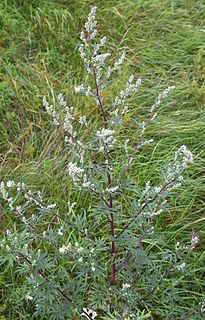
Artemisia vulgaris, the common mugwort, is a species of flowering plant in the daisy family Asteraceae. It is one of several species in the genus Artemisia commonly known as mugwort, although Artemisia vulgaris is the species most often called mugwort. It is also occasionally known as riverside wormwood, felon herb, chrysanthemum weed, wild wormwood, old Uncle Henry, sailor's tobacco, naughty man, old man, or St. John's plant. Mugworts have been used medicinally and as culinary herbs.

The Crambidae are the grass moth family of lepidopterans. They are variable in appearance, the nominal subfamily Crambinae taking up closely folded postures on grass stems where they are inconspicuous, while other subfamilies include brightly coloured and patterned insects which rest in wing-spread attitudes.

The Pyraloidea are a moth superfamily containing about 16,000 described species worldwide, and probably at least as many more remain to be described. They are generally fairly small moths, and as such, they have been traditionally associated with the paraphyletic Microlepidoptera.

Ostrinia is a genus of moths in the family Crambidae described by Jacob Hübner in 1825. Several of them, including the European corn borer, are agricultural pests.
Ostrinia scapulalis, the adzuki bean borer or adzuki bean worm, is a species of moth in the family Crambidae. It was described by Francis Walker in 1859. It is one of 20 moths in the genus Ostrinia and is of Eurasian origin. The larvae have a gray mid-dorsal line and can be light pink or beige. The adult adzuki bean borer has a yellowish-brown forewing with jagged lines and variable darker shading, with a wingspan that ranges from 20 to 32 mm. The moths of this species are nocturnal and tend to be attracted to light.

Ostrinia furnacalis is a species of moth in the family Crambidae, the grass moths. It was described by Achille Guenée in 1854 and is known by the common name Asian corn borer since this species is found in Asia and feeds mainly on corn crop. The moth is found from China to Australia, including in Java, Sulawesi, the Philippines, Borneo, New Guinea, the Solomon Islands, and Micronesia. The Asian corn borer is part of the species complex, Ostrinia, in which members are difficult to distinguish based on appearance. Other Ostrinia such as O. orientalis, O. scapulalis, O. zealis, and O. zaguliaevi can occur with O. furnacalis, and the taxa can be hard to tell apart.
Ostrinia avarialis is a moth in the family Crambidae. It was described by Hans Georg Amsel in 1970 and is found in Afghanistan.
Ostrinia dorsivittata is a moth in the family Crambidae. It was described by Frederic Moore in 1888. It is found in Darjeeling, India and China.
Ostrinia erythrialis is a moth in the family Crambidae. It was described by George Hampson in 1913. It is found in the Democratic Republic of the Congo, Malawi, Nigeria and South Africa.
Ostrinia kasmirica is a moth in the family Crambidae. It was described by Frederic Moore in 1888. It is found in Kashmir and Russia.
Ostrinia kurentzovi is a moth in the family Crambidae. It was described by Akira Mutuura and Eugene G. Munroe in 1970. It is found in the Russian Far East (Ussuri).
Ostrinia latipennis is a moth in the family Crambidae. It was described by Warren in 1892. It is found in Japan and the Russian Far East.
Ostrinia marginalis is a moth in the family Crambidae. It was described by Francis Walker in 1866. It is found in North America, where it has been recorded from Newfoundland and Maine west to Alberta, the Northwest Territories and Yukon. The habitat consists of bogs and marshes.
Ostrinia obumbratalis, the smartweed borer, is a moth in the family Crambidae. It was described by Julius Lederer in 1863. It is found in North America, where it has been recorded from New Brunswick and Manitoba to Louisiana and Florida.
Ostrinia ovalipennis is a moth in the family Crambidae. It was described by Suguru Ohno in 2003. It is found in Japan, where it has been recorded from Honshu and Hokkaido.

Ostrinia penitalis, the American lotus borer, is a moth in the family Crambidae. It was described by Augustus Radcliffe Grote in 1876. It is found from Mexico, through Central America to Amazonas, Brazil. It is also found in North America, where it has been recorded from Quebec to British Columbia and most of the United States. The habitat consists of marshes and pondsides.
Ostrinia putzufangensis is a moth in the family Crambidae. It was described by Akira Mutuura and Eugene G. Munroe in 1970. It is found in China.
Ostrinia zaguliaevi is a moth in the family Crambidae. It was described by Akira Mutuura and Eugene G. Munroe in 1970. It is found in the Russian Far East, Japan and China.

Ostrinia zealis is a moth in the family Crambidae. It was described by Achille Guenée in 1854. It is found in the Russian Far East, Japan, China and India.
Eugene Gordon Munroe was a Canadian entomologist who discovered numerous species of insects. He worked for the Insect Systematics and Biological Control Unit, Entomology Division in Ottawa, Canada.






